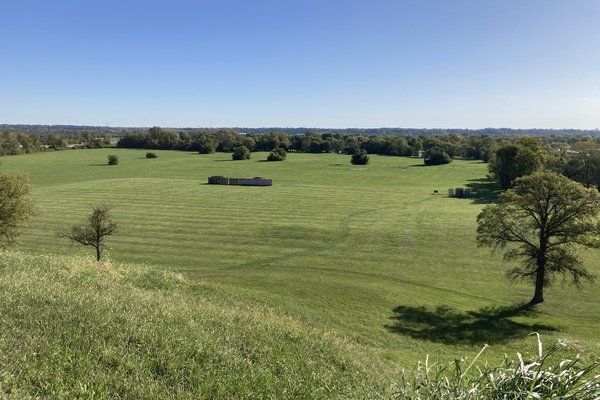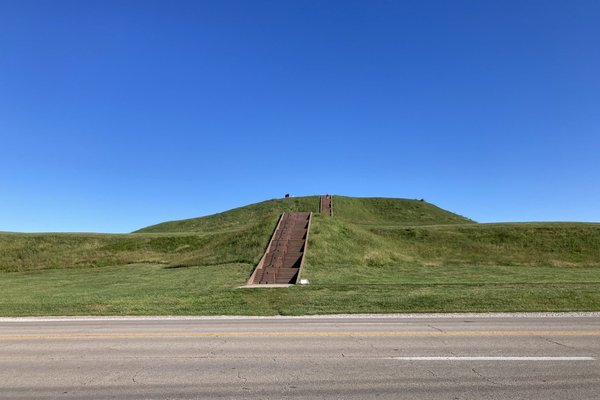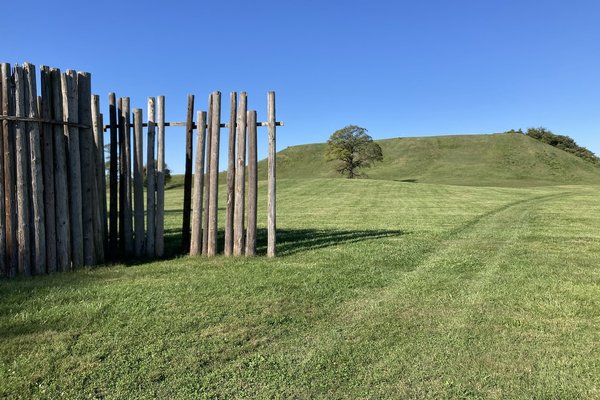United States of America
Cahokia Mounds
Cahokia Mounds State Historic Site comprises the archeological remains of an agricultural settlement of Pre-Columbian civilizations in the Mississipi region.
10,000 people may have lived here and at its peak (11th century) there were some 120 earthen mounds, of which 81 remain. They were used as burial sites and provided defensive protection to public buildings. The 30m high Monks Mound is the largest prehistoric earthen structure uncovered so far in the New World.
Community Perspective: a little-known site among the general public, but reviewers enjoyed climbing the main mound, the site museum and appreciated the importance of this “largest pre-Columbian city north of Mexico”. 1.5 hours should be sufficient to cover it. It lies close to St. Louis in Missouri and Eero Saarinen’s Gateway Arch.
Site Info
Official Information
- Full Name
- Cahokia Mounds State Historic Site (ID: 198)
- Country
- United States of America
- Status
-
Inscribed 1982
Site history
History of Cahokia Mounds
- 1982: Inscribed
- Inscribed
- Type
- Cultural
- Criteria
- iii
- iv
Links
- UNESCO
- whc.unesco.org
- Official
-
- cahokiamounds.org — Cahokia Mounds State Historic Site
- Related
-
- vimeo.com — Augmented Reality Tour
All Links
UNESCO.org
- whc.unesco.org — whc.unesco.org/
Official Website
- cahokiamounds.org — Cahokia Mounds State Historic Site
Related Resources
- vimeo.com — Augmented Reality Tour
News Article
- Jan. 17, 2021 sfchronicle.com — Ohio Supreme Court sets date for ancient burial mound case
- July 19, 2019 wsiltv.com — Bill introduced to make Cahokia Mounds a national park
- Sept. 22, 2015 westerndigs.org — Cahokia’s Monks Mound May Have Been Built in Only 20 Years
- May 6, 2015 popular-archaeology.com — Cahokia's rise and fall linked to river flooding
- Feb. 25, 2015 news.stlpublicradio.org — State budget problems force cuts, crowdfunding at Cahokia Mounds
- Feb. 17, 2010 bnd.com — Archaeologists uncover Stone Age copper workshop near Monk's Mound at Cahokia Mounds State Historic Site
- July 19, 2008 chicagotribune.com — Cahokia Mounds to get audio-guided tours in English, Spanish and German
- Aug. 23, 2007 chicagotribune.com — Cahokia Mounds expanding, hoping for more archaeological finds: Finding buried remnants of ancient civilization on the newly acquired land "is a very distinct possibility," said Robert Coomer, director of the Illinois Historic Preservation Agency, which manages the site. Anything within a two- or three-mile radius of Cahokia Mounds, he says, "has potential for a significant archaeological find."
Community Information
- Community Category
- Archaeological site: Pre-Columbian
Travel Information
Free entrance
Undergoing Restoration or Repair
Recent Connections
-
Undergoing Restoration or Repair
The site museum/interpretative center i… -
Free entrance
Entrance is free of charge, although a … -
Astronomy and Astrology
Woodhenge: "The circle has been used to…
Connections of Cahokia Mounds
- Geography
-
-
Mississippi Basin
situated a few mile east of the Mississippi. Nearby “Horseshoe Lake” was hydrologically connected to the River until 20th C flood protection measures totally separated it
-
- Trivia
-
-
In Video Games
Civilization VII: Monks Mound
-
- World Heritage Process
- Human Activity
-
-
Human Sacrifice
"Archeologists recovered more than 250 other skeletons from Mound 72. Scholars believe almost 62% of these were sacrificial victims, based on signs of ritual execution, method of burial, and other factors" (wiki)
-
- Constructions
-
-
Pyramids
"Monks Mound is the largest Pre-Columbian earthwork in the Americas and the largest pyramid north of Mesoamerica" (wiki)See en.wikipedia.org
-
Large squares
Grand Plaza, 190000 m2 -
Timber circles
-
Passage of the Sun
"The most spectacular sunrise occurs at the equinoxes, when the sun rises due east. The post marking these sunrises aligns with the front of Monks Mound, where the leader resided, and it looks as though Monks Mound gives birth to the sun" -
Tumuli
"The mounds served variously as construction foundations for public buildings and as funerary tumuli." (OUV)
-
- Timeline
-
-
Built in the 9th century
was occupied primarily during the Mississippian period (800-1350) (AB ev), mound building at this location began with the Emergent Mississippian cultural period, about the 9th century CE (wiki)
-
- Science and Technology
-
-
Astronomy and Astrology
Woodhenge: "The circle has been used to investigate archaeoastronomy at Cahokia. Annual equinox and solstice sunrise observation events are held at the site." (wiki)See en.wikipedia.org
-
- Visiting conditions
-
-
Free entrance
Entrance is free of charge, although a donation of $4 for adults $2 for children, and $10 for families is suggested. -
Undergoing Restoration or Repair
The site museum/interpretative center is closed for renovations "until further notice" (still valid July 2023)
-
News
- sfchronicle.com 01/17/2021
- Ohio Supreme Court sets date for a…
- wsiltv.com 07/19/2019
- Bill introduced to make Cahokia Mo…
- westerndigs.org 09/22/2015
- Cahokia’s Monks Mound May Have Bee…
Recent Visitors
Visitors of Cahokia Mounds
- Alberto Rodriguez Gutierrez
- Alexander Lehmann
- Alex Baranda
- Alex Goh
- Allan Berry
- Ana
- Atila Ege
- AYB
- Bill Maurmann
- Bin
- blake
- Bluewonder310
- Brendan Carroll
- Brett Baumann
- brornt
- Can SARICA
- Christravelblog
- Cobaltrage
- Colossus
- Dagmara
- Daniel Chazad
- dave wood
- David Aaronson
- David Scott King
- Dennis Nicklaus
- Dimitar Krastev
- Dolemite92
- Don Irwin
- DonQuijote
- Els Slots
- Eric Lurio
- Erik G
- Fan Yibo
- Folkokovic
- Frédéric M
- Frederik Dawson
- Gary Arndt
- George Gdanski
- GerhardM
- Hadrianus
- Harry Mitsidis
- Hdhuntphotography
- Iain Jackson
- Ian Cade
- IreneKD
- Jacob Choi
- Janos
- Jan Zimmermann
- Jason Boulette
- Javier Coro
- Jawnbeary
- Jay T
- Jeanne OGrady
- Jennjenn
- Karito Vies
- Kedp2023
- kjluebke
- Klaus Freisinger
- KngAlaric
- Kurt Lauer
- Kyle Magnuson
- Lameduck99
- Lee Kai Loong
- leroykstlj
- lichia
- Lillybett
- Little Lauren Travels
- Lucas Del Puppo
- Mardigny
- Marty
- Matthewsharris
- Michael Ayers
- MichaelH
- Michael Novins
- Mihai Dascalu
- MMM
- Mstrebl1990
- Nick Kuzmyak
- Patrik
- Pchxiao
- Petteri
- Philipp Peterer
- Rachel Perkins
- Randi Thomsen
- Reza
- Roger Ourset
- Roman Bruehwiler
- Samy G
- sandersx2
- Solivagant
- stephhollett
- Svein Elias
- Tamara Ratz
- Thomas Buechler
- tony0001
- Tsunami
- Velvetlapis
- Wimmy
- ZCTLife
- zman5455
- Zoe
- Zoë Sheng
Community Reviews
Show full reviews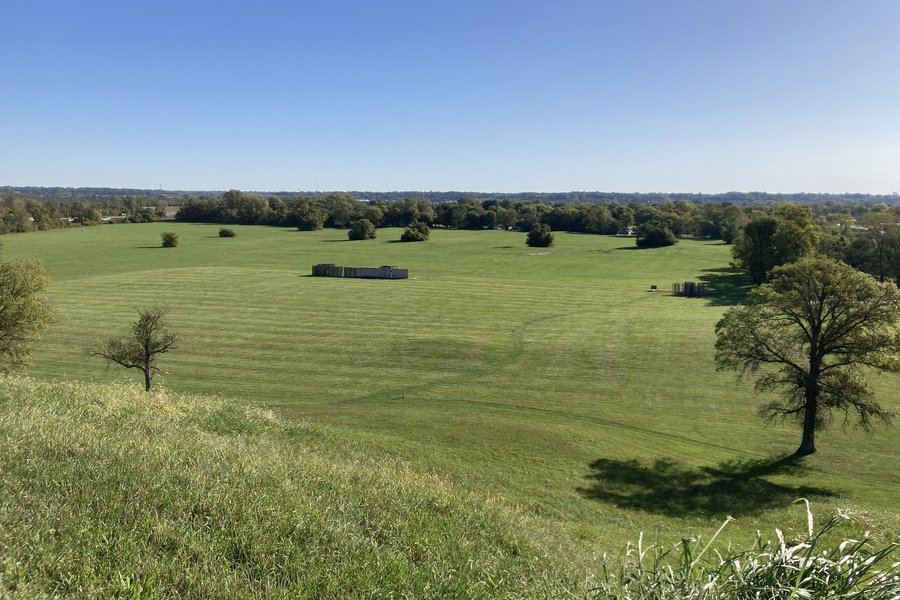
Cahokia Mounds was the first of the three ‘earthen mounds’ WHS I planned to visit on this US trip. Honestly, I did not have high expectations. I was anticipating some Viking-style heaps of soil covered by grass, revealing few clues of what had happened there in the past. But this is so much more impressive.
Already, while reading up on the site beforehand, I noticed similarities with Teotihuacan (which is much older, by the way, and had ten times as many inhabitants, to put it in perspective). There are a number of drawings used in the interpretation of the site that show what ‘Cahokia City’ may have looked like (see top photo). You have this gigantic mound (Monks Mound), which probably was the ceremonial center and residence of the chief. It is slightly larger than the Temple of the Sun in Teotihuacan. There was a Grand Plaza as well as numerous funerary tumuli. Over 10,000 people are believed to have lived in the city in its heyday around the year 1100.
This is also a WHS ‘connected to a road’ – you can’t get away from the fact that a major road crosses the site, separating the Monks Mound and the reconstructed Woodhenge from the rest of the mounds. This is the US, so no one apparently has thought of at least adding a pedestrian crossing and some speed bumps to let people safely cross on foot. The same road (well, a forerunner: the National Road), however has been instrumental …
Keep reading 0 comments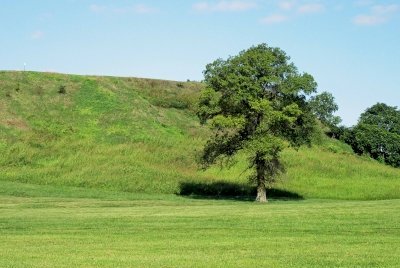
It's rather striking to compare and contrast the first two US World Heritage Sites dedicated to pre-Columbian North American civilizations. Mesa Verde, in the American Southwest, retains impressive adobe structures built into cliffsides, where Pueblo civilizations would live while farming on the fields above. Cahokia Mounds, on the other hand, retains only earthen mounds left behind from what was once the most advanced civilization north of Mexico. Mesa Verde was built in brick and stone, while structures at Cahokia Mounds were made of wood, which did not last through the centuries. Mesa Verde had the advantage of protection from the US federal government as early as the late 19th century. Cahokia Mounds, on the other hand, was in a prime location on the Mississippi River for European settlers. These settlers did not help in maintaining the integrity of the site; protections for Cahokia Mounds only came in the early 20th century. All this is to say that while it is admirable that the US has protected the heritage of pre-Columbian civilizations across the nation, visitors are more likely to be impressed with sites in the West than the East.
I traveled to Cahokia Mounds for a third visit on a road trip this past summer. The day was sunny and clear, and I was glad I started out in the morning, since the area around Cahokia Mounds gets rather hot and muggy on summer afternoons, and there is little in the way of protection from the sun around the …
Keep reading 0 comments
Hard to rate this one, since it depends on what metric you're going for. The site itself is pretty enough, and Wizard's Mound offers great views of the surrounding countryside and St. Louis, but archaeological sites are always a tough sell unless you study the stuff. Also, walking around an open field at -15C was not super fun.
Besides the relatively boring tourist aspect (though the museum is nice enough), this is a really important site. Not just because it had been the largest city in the US until Philadelphia eclipsed it in the late 1700s, but because that city had been built by indigenous people. The size, importance, and longevity of the settlement kind of remind me of the early writings on Great Zimbabwe: white settlers couldn't believe that the "savages" they'd fought upon colonization could have been capable of building such magnificent earthworks. To those who with an open mind (beyond what is taught in school), it really blows open the concept of "American history" to a much longer and more interesting timeline. Basically, what is now the US was populated by sophisticated, cosmopolitan cultures that were utterly wiped out over centuries of violence fueled by a superiority complex. It's a powerful lesson, and the site is possibly the best example of this proud indigenous history in the US.
Keep reading 0 comments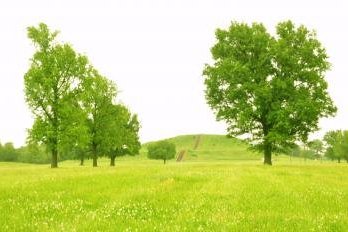
On the rainy day of May, after saw the impressive Eero Saarinen’s Gateway Arch and tried toast ravioli in central St Louis, I drove to Collinsville, Illinois to see the World Heritage Site, Cahokia Mounds. After got out from highway, I entered the archaeological zone. The road signs to Woodhenge and the gigantic Monks Mound were clearly visible along the route, but I decided to visit the museum and interpretive center first in order to get deeper understanding on Cahokia. Despite the rain, the carpark of the museum was surprisingly almost full.
Inside the museum, there was a very good replica of ancient village that show how ancient people of Cahokia lived. The story of sun worshipper society was a little Inca-liked to me, but still very interesting to know the existence of Mississippian culture which I have never heard before. The museum was indeed very nice, too bad that my visit happened to be in the same time of school trip, so the place was very noisy and full with children who did their school trip reports. Because of the rain, there were no children allowed to walk outside the museum, so to avoid the crowd I decided to walk along the trail to see the mounds. The walk really reminded me Gyeongju’s Tumuli Park with big and small mounds in the park. The twin mounds were maybe the most interesting one for its bigger size. Along the trail, I could see the Monks Mounds but there was no …
Keep reading 0 comments
Cahokia is worth a stop for anyone visiting St. Louis. It is a nice side trip from the city. If you are visiting the area solely for the Cahokia Mounds you may be disappointed. The site is deserving of its place on the world heritage list, the site Iis important. However, as a tourist site Cahokia does not offer much besides mounds that are evidence of a unique civilization.
The climb up the stairs to the top of the mound gives little knowledge of the site without being paired with the video in the visitor center.
The museum should not be overlooked, it is an excellent source of information about the site, and the video provides a insightful view of what makes Cahokia special. Overall, I enjoyed the experience as I'm especially interested in Native American history. For me 1.5 hrs was sufficient to enjoy the museum and site itself. On a clear day from the mound top you can see St. Louis in the distance.
Mound Building WHS
Cahokia is now one of three mound building WHS in the United States, some differences to consider. Pairing these sites together with other attractions is ideal. Poverty Point is the oldest of these properties and the most rural. Cahokia can be easily paired with St. Louis and even Chicago to the North. Hopewell, which is a serial property is found scattered between Cincinnati and Columbus, Ohio.
Keep reading 0 comments
The largest pre-Columbian city north of Mexico, Cahokia is a major archaeological site (it had a population larger than London's in the 13th century), but little known even within the US. For those with a reasonably big interest in history and archaeology, this is a very rewarding place to visit, but be sure to see the excellent museum in the visitor centre, and to join a (free) guided tour (very informative). Otherwise all those hills scattered around the area won't make much sense to you. If you climb atop the largest one, called Monk's Mound, you can even see the skyline of St. Louis and the Gateway Arch. The site can be reached by public transport as well (metro train to East St. Louis, then bus to Collinsville, then a 25-minute walk - not as bad as it sounds). I was pleasantly surprised that they really highlighted their WH status - not a matter of course in the US. There was even a WH flag next to the American one at the entrance - never seen one of those before...
Keep reading 0 comments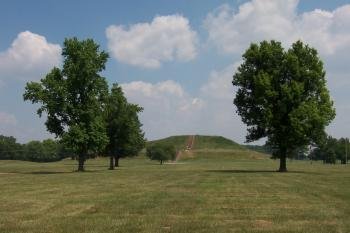
The site is actually the largest Pre-Colombian city north of Mexico and formerly had a population of around 15,000, the main aspect of the park are the 69 man made mounds, the largest of which is the Monks Mound (pictured) which is around 100ft tall. This is the most impressive part of the site and from the top you get a good over view of most of the site, and you can see central St. Louis. The rest of the site is spread around and basically consists of a lot of grass mounds that vary in size and a ‘woodhenge’ calendar, if I am being honest it was not hugely impressive to see but it was very interesting none the less.
The interpretive centre has some interesting exhibits and a recreation of the houses that would have stood in the city, also there was an extremely good video which gives a great introduction, and talks about how and why the civilisation evolved in this area, it made me think of the things I read about evolution of civilisation in Mesopotamia at the University of Chicago the day before. The reasons for the development of a city here were similar as were the structures which were a little like basic Ziggurats. The interpretive centre is closed on Mon-Tue but the park is open all the time.
This site is just outside St. Louis and I managed to see it on a long day trip down from Chicago. If you are here …
Keep reading 0 comments
Cahokia Mounds is located just east of St. Louis, MO. This was the last of the USA world heritage sites that I visited. The natural site was very interesting. Some of the mounds are more than 100 ft. tall. The site contains at least 70 mounds that are between 800 and 1000 years old. The entire site (a large residential city of the Mississippean Native Americans) was almost completely surrounded by a very impressive fortress.
The museum at the mound site is quite good. It has actual artifacts unearthed at the site as well as representations of the city. Several grave sites have been excavated here. One, a high ranking man, was wrapped in a cloak covered with more than 10,000 round shells sewn into the shape of an eagle.
The site is all the more interesting since it presents a fascinating contrast between present day Mississippi river life and that of a millenium ago. (You can see downtown St. Louis and the Gateway Arch from the top of the Monk's Arch)
Keep reading 0 comments
I went to the Cahokia Mounds pretty much as a last minute visit before heading out of Saint Louis, I just saw the sign and decided to go there. I am glad I did. I had no idea this even existed but am glad I took the time to learn about it. It was a very intresting site, did not take long to go through but was very informative. I am generally not intrested in archeological stuff but even I found it intresting. I recommend taking an hour out of your day as you pass by and visit it. It is worth the look and it's free (although you can spend money in thier gift shop, or through donations if you want)
Keep reading 0 comments
